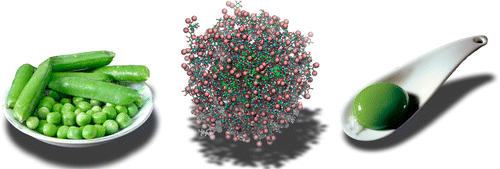Deconstruction of avant-garde cuisine could lead to even more fanciful dishes

One of the most iconic forms of avant-garde cuisine, also known as molecular gastronomy, involves the presentation of flavorful, edible liquids—like cocktails or olive oil—packaged into spheres. Now a team of scientists, in collaboration with world-renowned chef Ferran Adriá, is getting to the bottom of what makes these delectable morsels possible. Their findings appear in ACS' The Journal of Physical Chemistry B.
Christophe Chipot, Wensheng Cai and colleagues explain that the technique of "spherification" was invented 70 years ago but was popularized in avant-garde cuisine more recently by Adriá. The process of making the spheres involves packaging juice or other liquid ingredients in envelopes of calcium alginate, a gelatinous substance made mostly out of molecules extracted from brown seaweed. Although spherification has become a prominent technique in molecular gastronomy, no one had investigated the formation and stability of the alginates at the atomic level. Chipot's team wanted to change that.
The researchers used classical molecular dynamics techniques to probe how alginate spheres form. Among other discoveries, they found that alginate chains spontaneously wrap like a net around liquid droplets and that calcium ions were key. They concluded that studies such as these, which bridge the gap between material science and avant-garde cuisine, could help chefs and food scientists rationally design the next generation of innovative cooking techniques.
More information: "From Material Science to Avant-Garde Cuisine. The Art of Shaping Liquids into Spheres" J. Phys. Chem. B, Article ASAP. DOI: 10.1021/jp508841p
Abstract
Employing avant-garde cuisine techniques, in particular sodium alginates, liquid food can be shaped into spheres, thereby conferring to the former original and sometimes unexpected forms and textures. To achieve this result, rational understanding of the science that underlies food physical chemistry is of paramount importance. In this contribution, the process of spherification is dissected for the first time at the atomic level by means of classical molecular dynamics simulations. Our results show that a thin membrane consisting of intertwined alginate chains forms in an aqueous solution containing calcium ions, thereby encapsulating in a sphere the aliment in its liquid state. They also show why the polysaccharide chains will not cohere into such a membrane in a solution of sodium ions. Analysis of the trajectories reveals the emergence of so-called egg-box spatial arrangements, which connect the alginate chains by means of repeated chelation of one calcium ion by two carboxylate groups. Free-energy calculations delineating the formation of these egg-box structures further illuminate the remarkable stability of such tridimensional organizations, which ensures at room temperature the spontaneous growth of the polysaccharide membrane. Spherification has been also examined for liquid aliments of different nature, modeled by charged, hydrophilic and hydrophobic compounds. The membrane-encapsulated food is shaped into robust and durable spheres, irrespective of the liquid core material. By reconciling the views of spherification at small and large scales, the present study lays the groundwork for the rational design of innovative cooking techniques relevant to avant-garde cuisine.
Journal information: Journal of Physical Chemistry B
Provided by American Chemical Society

















